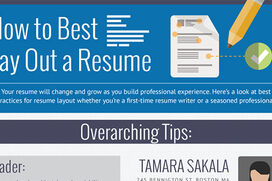
How to Best Lay Out a Resume
Whether you're an entry-level job seeker or a seasoned professional, you'll want to revamp your resume before you dive into the job hunt. This essential document will evolve frequently, so it's important that you understand the do's and don'ts of formatting so you can keep your resume polished.
Here's some guidance when it comes to laying out a resume.

Overarching resume tips
Before you hone in on specific sections of your resume, you'll want to step back and look at the document as a whole. Resumes that look sloppy or unprofessional are more likely to get tossed aside, so it's essential that you take these factors into account to make a good first impression.
Header
One seemingly simple yet incredibly important section of a great resume is the header. This section should include your name, address and contact information. Design your resume header with style and readability in mind. The last thing you want is for an impressed employer to be unable to read your email address because you chose an overly fancy font.
Once you've created a great header, be sure to use the same formatting on your cover letter for consistency.
Style
Sometimes novice job seekers are overly ambitious when formatting their resumes and go overboard when selecting fonts, sizes and spacing. Limit these factors to a few simple and readable choices. After all, your resume should be about your skills and experience - you don't want a recruiter to be distracted by added flourishes.
Tone
Consistency is key when it comes to the style and tone of your writing. Stick to first person when you're creating a profile, objective or job description, but limit your use of personal pronouns like "I" or "me." You should use past tense when describing your former jobs and associated responsibilities.
Quadrant test
If your internship section takes up three-fourths of your resume, the document may seem unbalanced to interviewers. This is where the quadrant test comes in handy.
Divide your resume into four equal horizontal sections. Then, look at each section for overall balance. Make sure each quadrant has roughly the same number of headers and bullet points. This will ensure that the document is easy for recruiters to scan through.
Resume sections
Once your resume has been formatted on a larger scale, it's time to delve into the specific sections. Use these tips to optimize the different areas of your resume.
Education
As a recent graduate or entry-level professional, this section is likely one of the most important on your resume. Place your educational information under the header. This should include your degree, relevant coursework, extracurricular and GPA - if it's worth noting. Once you have professional experiences that relate to your job search, this section can be moved down toward the bottom of the document.
Skills and qualities
In this section, you should list any skills that directly relate to the job you're applying for. Use the job description to decide which qualities to include and what to leave off. A skills section is especially important if your education differs from the field of work you're exploring.
Career objective
Many job seekers like to include a short paragraph about their professional goals, but you have to be careful when writing this section of your resume. Your objective should directly relate to the position you're seeking. If your goals don't really align with the job or company mandate, you may want to leave this section off so it doesn't hurt your chances of securing the position.
Experience
This is where you'll list your professional work experience - if you have it. As a recent grad, the experience section should be under your education. You can include internships and volunteering in your experience section. Once you have a few jobs under your belt, shift this section of your resume toward the top of the document.
 Back to Top
Back to Top